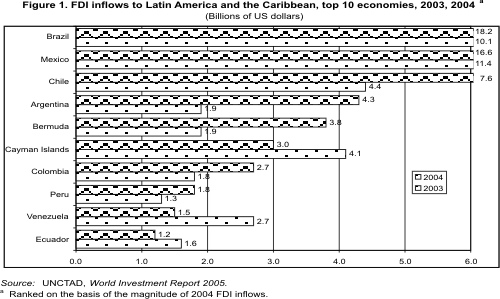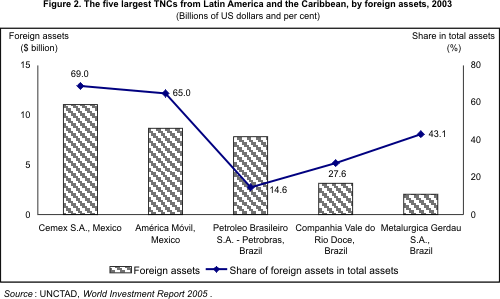| EMBARGO The contents of this press release and the related Report must not be quoted or summarized in the print, broadcast or electronic media before 29 September 2005, 17:00 GMT (1 PM New York, 19:00 Geneva, 22:30 Delhi, 02:00 - 30 September Tokyo) |
Foreign direct investment (FDI) inflows to Latin America and the Caribbean rose by 44% last year, to US$ 68 billion, after four consecutive years of decline, according to UNCTAD´s World Investment Report 2005: Transnational Corporations and the Internationalization of R&D (1) , released today. The resurgence in FDI occurred in 28 of the 42 economies in the region for which data are available. Brazil and Mexico consolidated their positions as the largest recipients of this investment, accounting for 27% and 25% of the total, respectively.
The report, known as WIR05, features a special section on transnational corporations and the internationalization of research and development.
The largest FDI increases in Latin America and the Caribbean occurred in MERCOSUR member and associate member countries, especially Argentina (125%), Brazil (79%) and Chile (73%) (fig.1). The report attributes the strong growth in investment in Central America and the Caribbean mainly to a 46% rise in inflows to Mexico. In the Andean Community, total inflows remained almost the same as in 2003. Notable exceptions were Colombia and Peru, which had clear upturns of 53% and 37%, respectively, and Venezuela, Ecuador and Bolivia, which saw decreases.
In terms of FDI outflows from the region, Brazil accounted for the largest share -- US$ 9.5 billion -- of the total of US$ 11 billion. Overall, outflows stayed about the same as in 2003. The largest Latin American transnational corporations (TNCs) in the region are from Mexico and Brazil (fig.2).
A combination of regional and global factors explains the FDI upturn. Strong economic growth in the region following a long period of stagnation revived market-seeking FDI, the report says, while at the global level, improving economic conditions encouraged export-led FDI, and a strong increase in demand for commodities boosted resource-seeking FDI. The manufacturing sector was the main recipient of FDI arriving in Brazil and Mexico, surpassing the services sector for the first time since 1996 and 2000 respectively. Service-related activities in South America continued to experience divestments by foreign firms last year, sustaining a trend that began in the early 2000s.
The year 2004 saw major changes in policy towards private investment in the natural resources sector, where inflows come largely from foreign firms, the report notes. The strong rise in commodity prices led some governments to modify their tax regimes and change legislation so that states can secure a major share of the rent coming from natural resources. Shifts of this sort occurred in Argentina, Bolivia, Chile, Peru and Venezuela. While such measures tend to have a dampening effect on FDI, other policy changes were made that could have market appeal for foreign investment, such as new investment promotion regimes in Argentina and Brazil that target industrial activities, and measures in some Caribbean nations to end monopolies in the telecom sector.
Further rises expected this year
FDI flows to Latin America and the Caribbean are expected to rise further in 2005, the report predicts, as most of the driving forces behind their expansion in 2004 appear set to continue. After a prolonged period of economic stagnation in the region from 1999 through 2003, investments will be needed to modernize and expand production capacity and remove infrastructural bottlenecks, mainly in energy, roads and ports, so as to meet growing internal and external demand. Rising demand from China for natural resources has created expectations of substantial increases in Chinese FDI flows to Latin America and the Caribbean in coming years.
| The World Investment Report and its database are available online at www.unctad.org/wir and www.unctad.org/fdistatistics . A complete set of UNCTAD´s major publications on FDI and TNCs - the UNCTAD/UNCTC Digital Library - can be found at http://unctc.unctad.org . |
ANNEX
Tables and figures
Figue 1: FDI inflows to Latin America and the Caribbean, top 10 economies, 2003, 2004 (Billions of US dollars and per cent)
Figure 2: The five largest TNCs from Latin America and the Caribbean, by foreign assets, 2003 (Billions of US dollars and per cent)


